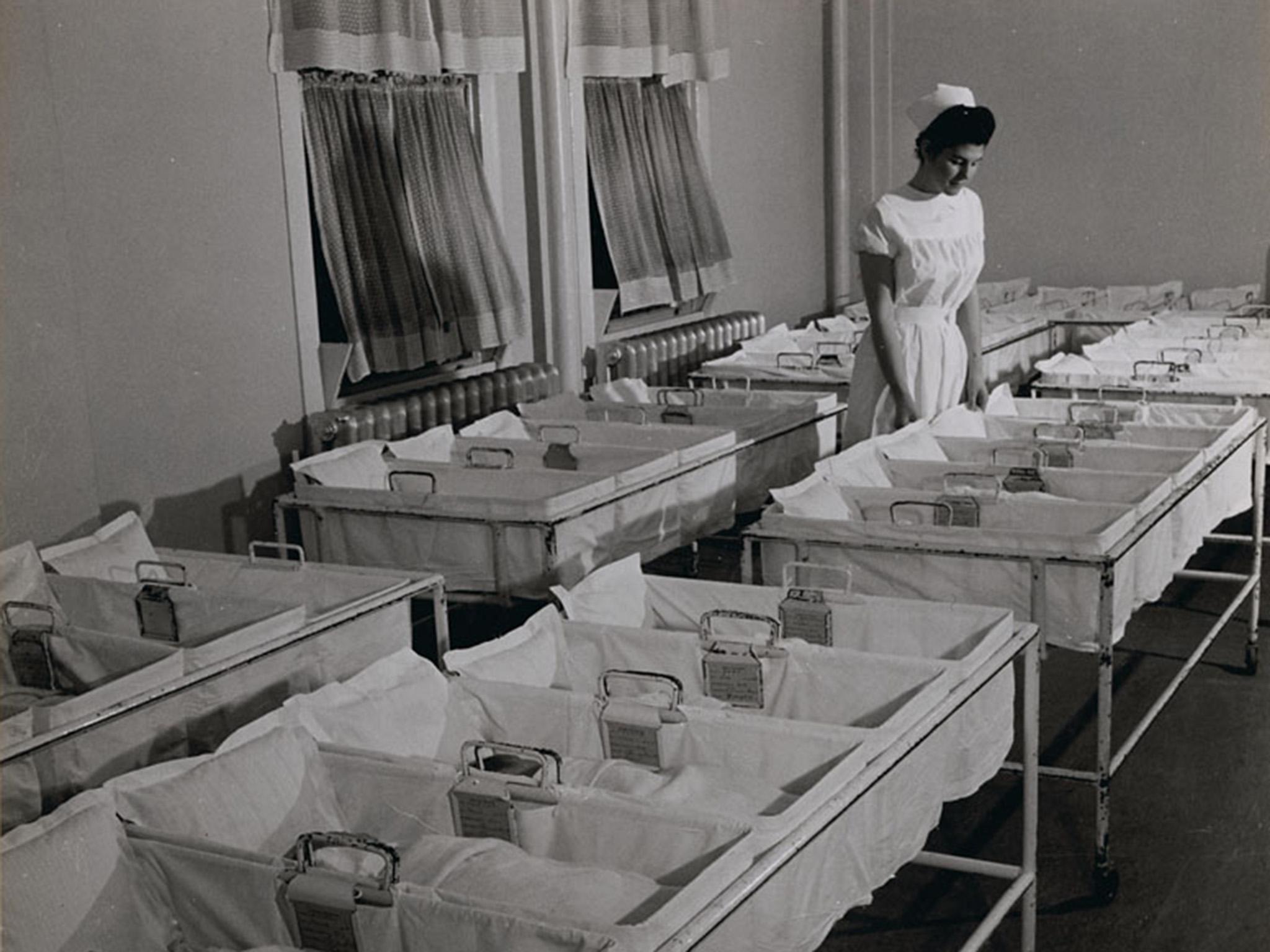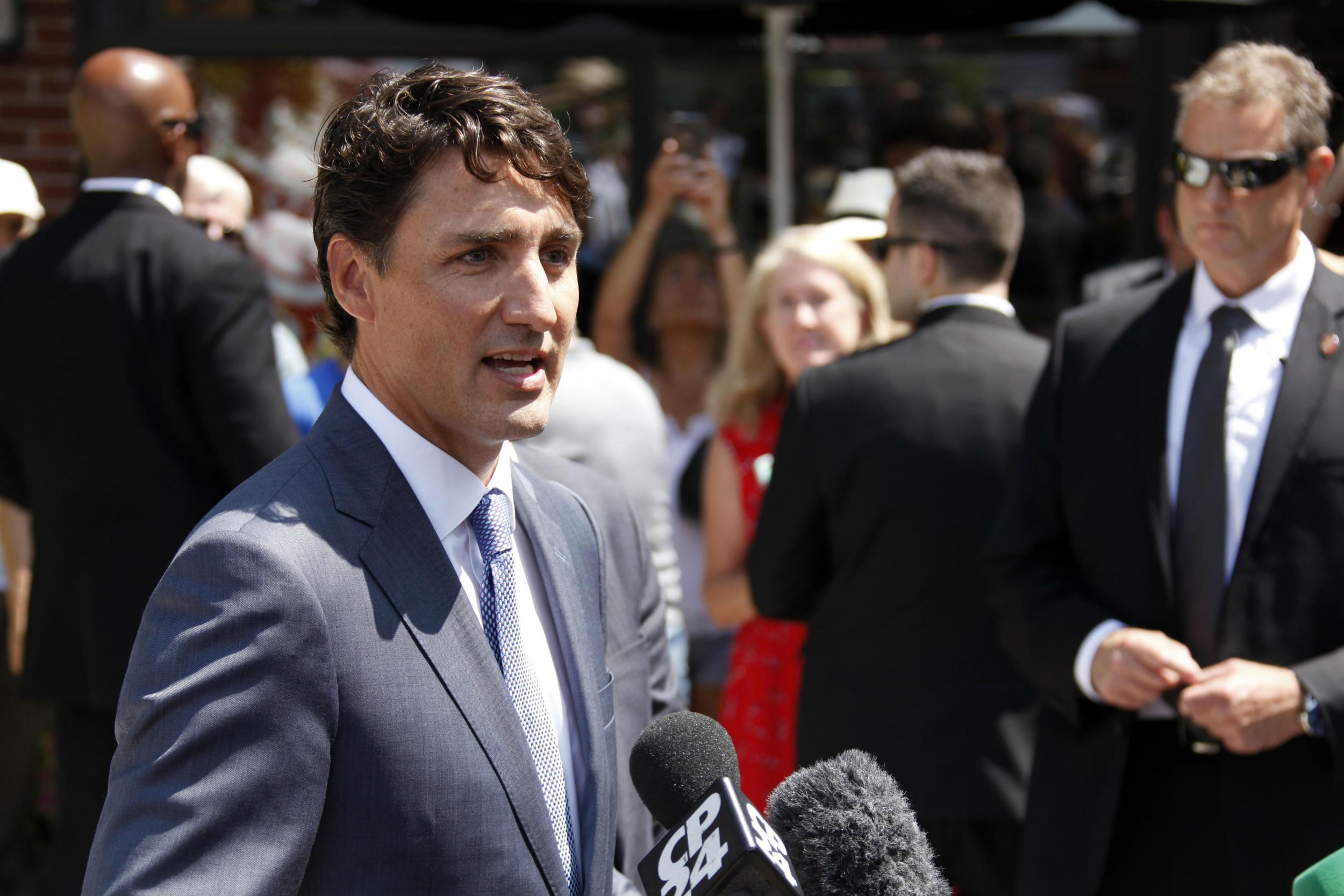Where’s my baby? How Canada confronted the scandal of forced adoption
Between 1945 and 1975, hundreds of thousands of unmarried Canadian women were forced to give up their children to adoptive parents. Andrew Buncombe talks to victims of this bleak chapter and asks why the Trudeau government refuses to apologise


It had been 50 years since Sandra Jarvie was told to sign a form consenting to give up her newborn baby. Yet when she tried to talk about it, all those decades later, her voice faltered, and her words were almost trapped.
“I was totally numb. My baby was gone,” she says. “The social worker stood in front of me. Coldly, she said: ‘You will never see your baby again as long as you live. If you search for the baby, you’ll destroy his life and the lives of the adoptive parents.’”
Jarvie’s words, given as testimony to an official inquiry, have helped to draw attention to one of Canada’s most agonising scandals and one which for decades was covered up – the forced adoption of hundreds of thousands of babies born to unmarried mothers. Between 1945 and the early 1970s, as many as 450,000 babies – some say the figure is higher – were forcibly taken from their mothers amid a climate of church and society-created shame and guilt. Almost 600,000 births were registered as “illegitimate”.
The mothers were sent to special homes, often miles away, and told they were sinful. It was drilled into them that giving their child to a married couple was better for the baby. Many were told to “get a puppy” instead. Most were never permitted to hold or even look at their babies.
The young fathers’ rights were equally ignored. In most cases, a father’s name was not entered on the birth certificate if he and the child’s mother were not married.
The scandal, which the Canadian government has never officially recognised, let alone apologised for, created trauma for vast numbers of people – the mothers, the children taken from them, and their families. Mothers bore a sense of guilt and loss that they never got over. Most never stopped thinking about the child they had been forced to give up, even if they subsequently had others. Large numbers suffered from depression; some took their own lives.
Children – when they learned they were adopted – wondered why they had been given up. They asked about their ancestry, about their birth parents. All the while, the institutions involved, the church groups, the provincial governments and private homes, worked to cover up what had happened and made it difficult to obtain information.
Yet Canada’s faltering national reckoning with this dark episode – a recent report by a senate committee was titled ‘The Shame is Ours’ – is only one of several taking place around the globe. Britain, the United States, Ireland, Australia and New Zealand all, to a greater or lesser degree, pursued policies of forced adoption after the Second World War. Advocates say across the Anglosphere, millions of women had their babies taken from them during the so-called baby-scoop era.
In Britain, Labour MP Alison McGovern has said as many as 500,000 women may have been affected by forced adoptions that took place mainly in the 1950s and 1960s and has backed calls for an apology from prime minister Theresa May. The Catholic Church of England and Wales apologised for its role in 2016, when Cardinal Vincent Nichols acknowledged “the grief and pain caused by the giving up of a child through adoption”.
Last month, at a shrine in the city of Knock in County Mayo, Ireland, Pope Francis denounced the way thousands of Irish babies had been “robbed of their innocence and taken from their mothers” by Catholic-run institutions. “This open wound challenges us to be firm and decisive in the pursuit of truth and justice.”
In the US, researcher Karen Wilson-Buterbaugh – who was herself forced to give up her baby – has estimated that between 1945 and 1973, the year the US Supreme Court made abortion legal, up to 1.5 million mothers had their babies coercively taken away.
In 2013, then Australian prime minister Julia Gillard apologised to tens of thousands of women. “To you, the mothers – who were betrayed by a system that gave you no choice and subjected you to manipulation, mistreatment and malpractice – we apologise,” she said.

Alongside the forced adoption of unmarried mostly white mothers in the post-war period in Canada and Australia, successive governments also carried out enforced adoptions of unknown thousands of indigenous and aboriginal children – termed the stolen generations – up until the 1970s and 1980s. In Canada, it stopped only after a 1983 exposé by author Patrick Johnson. In October 2017, the Canadian government reached a settlement with those affected totalling C$800m (£470m).
Chief Marcia Brown Martel, of the Beaverhouse First Nation and the lead plaintiff, told reporters: “I have great hope that because we’ve reached this plateau, this will never, ever happen in Canada again.”
The adoption constellation
For years, Monica Byrne wondered what happened to the daughter she had been forced to give up as an unmarried mother in 1966. The authorities refused to help her find out, so instead she played “private detective”. Eventually in 1989, married and with three other children, she was able to track down and meet her first child. The pair now have a good relationship; that is not the case for all reunifications. She says her daughter has two families that love her.
Byrne now helps others. Working with Parent Finders, a nationwide group, Byrne offers support and advice to all parties in what she calls the adoption triangle: the birth mother, the child and the adoptive parents.
Speaking from Ottawa, she says the impact of forced adoption affected people in different ways. Most women, she says, were unable to put it behind them entirely, even if, like her, they had families and other children.
Wendy Rowney was born on a cold December day three weeks before her mother’s 18th birthday. Almost immediately afterwards, she was placed with new parents. She was later told her birth mother saw her only briefly, once in the delivery room and then through a glass window, when they identified her as the newborn’s mother as she was forced to leave. She never held her, Rowney later learned, because her mother said if she did, she could not have given up her up.

Rowney is president of Adoption, Support, Kinship (ASK), a Toronto-based group that helps those looking to find and reunite with their birth parents. “I don’t know how to explain to you what it is like not to know. I can tell you that this absence of knowledge is not a trivial thing. It is not something you get over or forget about,” she testified in March before a hearing of the Canadian Senate Committee on Social Affairs, Science and Technology.
She said she had been speaking recently with many fathers whose babies were taken. She said their stories “mirror that of young mothers in that they felt very powerless”.
“Many of them speak of feeling emasculated over the years because they were unable to protect their child and the woman they loved. In our society, certainly in those years, that was perceived to be a man’s role,” she told the committee.
Rowney was able to reunite with her own mother 20 years ago. “Like all relationships, you have to work at it,” she said.
Cruelty
The treatment of the unmarried mothers was nothing less than staggeringly cruel. The senate committee report, published in July, recorded how young women were sent away at up to five months into pregnancy, to around 60 homes run by churches, provincial governments and private individuals. Families told neighbours the girls “had gone away” to an aunt’s house to work or study.
As it was, in the homes partly funded by the federal government, they were subjected to a variety of abuses. They were forced to use false surnames and not permitted contact with the outside world, including their family and the father of their unborn child.
“Nurses, priests, social workers and other authority figures would reprimand the young women, telling them that they deserved punishment for their sins,” the report noted. “Punishment was delivered in various forms: humiliation, verbal abuse and dehumanising and degrading treatment. In some instances there was physical and sexual abuse.”
I interviewed 100 people in person. I don’t think I met one woman who did not start crying as they talked about it. And tears were usually running down my cheeks
After the women gave birth, the children were rapidly taken away. Sheets and curtains were used to hide the newborn child from the mother. The young women were given medication and had their breasts bound to prevent them lactating.
Routinely, they were given no information about the alternatives to adoption, even though the Canada Assistance Plan, set up in 1966, was officially established to provide financial aid in such circumstances. In an ugly twist, an occasional exception to this rule, senators were told, were unmarried mothers of colour whose babies “were not blue-ribbon babies” and therefore not considered as valuable by many Canadian adoptive parents. While babies of colour were sometimes sent as far away as France, those unmarried mothers were sometimes given assistance to raise their children.
Mothers were coerced and bullied into signing consent forms, constantly being told that giving up their baby was in the infant’s best interests. They were not told the records would be sealed.
Cold War
Scottish-born historian Veronica Strong-Boag has spent decades studying the history of women and children in Canada. She places its forced adoption policy within the broader context of society’s changing views on women, children and sexuality, and she provided expert testimony to the committee.
Others have compared the idealisation of giving birth, and the subjugation of women in a patriarchal society, to the dystopian world portrayed in Canadian novelist Margaret Atwood’s 1985 work, The Handmaid’s Tale.
Strong-Boag, professor of women’s history at the University of British Columbia, told the committee: “It was very much at the time of the Cold War, where we were seeing a reassertion of the notion of the priceless child in our battle with godless communism and a sentimentalisation and essentialisation of motherhood.”
In an interview from Vancouver, she says the issue of an apology is complicated because so many parts of society – the church, politicians and privately run maternity homes – bear responsibility. The federal government’s role was largely limited to providing some funding. “There was a widespread societal consensus that this was the answer to a problem,” she says. “We are all collectively responsible.”
Another piece of context was the struggle by women in Canada, and elsewhere in the world, for the right to access contraception. Elizabeth Bagshaw, one of the country’s first female doctors, was an early champion of the case and established its first family planning clinic in 1932, despite intense criticism. While birth control pills were approved in the US in 1960, their use in Canada was officially limited to “therapeutic” treatment until 1969, when the country also legalised abortion.
The girls who went away
Artist and documentary maker Ann Fessler was aged 56 when her biological mother finally agreed to meet her. It had taken some persuading, given the shame and confusion her mother still bore for giving her up over five decades earlier at the age of 19. Her mother insisted they meet in a town one hour from where she lived, and that they create a cover story for her should they meet anyone her mother knew. It would be five years before she told her other children they had a half-sister.
When she met her mother in 2005, Fessler had already documented the stories of more than 100 American women who had unwillingly given up their children, and had seen the toll it had taken on so many.
“I interviewed 100 people in person. I don’t think I met one woman who did not start crying as they talked about it,” she says, speaking from Rhode Island. “And tears were usually running down my cheeks.”
Fessler took the title for her 2006 book – The Girls Who Went Away – from the phrase families often used to explain a daughter’s absence after she had been sent to the maternity home. Her 2012 documentary is entitled A Girl Like Her.

She believes a number of factors created the forced adoption policy: social, cultural, economic and financial. One was the notion of the American Dream; with a new home, a blue-collar job that raised poor people into the middle class brought with it a level of perceived respectability. At that time, a pregnant, unmarried daughter could destroy that new-found respectability in a moment. And while young people were probably having sex at an earlier age, sex education in schools was all but absent, and access to contraception very difficult for unmarried women.
Moreover, if a girl became pregnant, they were immediately removed from school, undermining a future career or study. Far better, young women were told, to give up the baby as quickly as possible and return to society.
She says her mother died last year, after they had managed to develop a relationship. She has a reasonable relationship with her half-siblings and is now trying to track down her father’s side of the family. “My mother would not tell me,” she says. “Because she knew I would want to find them out.”
Healing
In Canada, large number of mothers and children have been fighting for access to records, an end to the silence and recognition of what happened to them. Adoption records are semi-open in eight of its 13 provinces or territories. This means an adoptee can file a paper demanding to know who their birth mother was, unless a veto has been placed.
They also want an apology, from the organisations and churches that carried out the policy, and the federal government which helped fund it. When the senate committee met this spring, only one of the numerous church groups involved in the scandal, the United Church of Canada, the largest protestant denomination in the country, agreed to take part. Its representative, Reverend Dan Hayward, offered regret – if not a full apology – for its role. “We grieve with all of those adopted children and families who have been harmed by unethical adoption,” he said.
Sandra Jarvie says: “I think the importance of an apology is that all our sons and daughters would know they were wanted because what has come out of that is that they were abandoned by us, and that isn’t the truth.”
Valerie Andrews, who was forced to give up her first child decades ago and who is now president of Origins Canada, which helps people separated from family members by adoption, says: “Yes, 100 per cent they should acknowledge it and validate that these things took place.”
Astonishingly, representatives of Canada’s federal and provincial governments contacted by the committee declined to appear.
The report by the committee, chaired by independent senator Art Eggleton, a member of prime minister Justin Trudeau’s Liberal Party, recommended the federal government apologise. Any apology must be accompanied by action, it said, adding that those affected should be involved in drafting the language. It also called for funding for more counselling, a public awareness campaign to acknowledge what happened and a law guaranteeing people access to adoption records that remain shut.
“A national apology is needed for the post-war adoptions forced on unmarried Canadian women and for the children they lost,” it said. “Time is running out for many of these Canadians.”
The Canadian government failed to respond to repeated requests from The Independent for comment. When the committee’s report was published in July, Michael Brewster, a spokesperson for Social Development Minister Jean-Yves Duclos, told the Globe and Mail: “We thank the senate for this report and we will be reviewing it attentively and responding to it.”
In an email, Eggleton says he’s not yet expecting more from Trudeau’s administration as the report had yet to be adopted by the entire senate because of the summer break. He planned to take up the issue this month, but added: “The emphasis of the report is on healing.”
Join our commenting forum
Join thought-provoking conversations, follow other Independent readers and see their replies
Comments